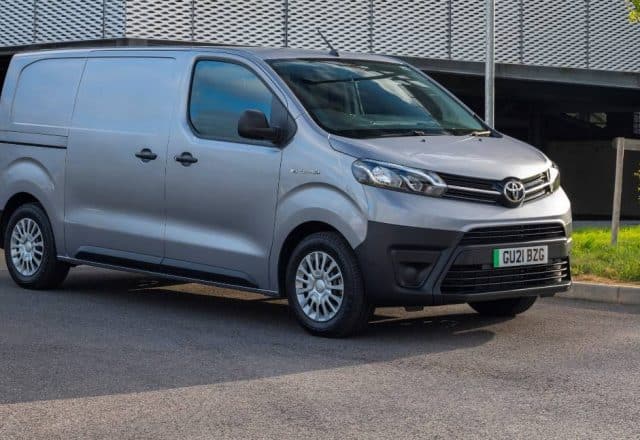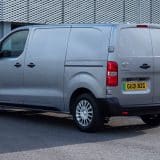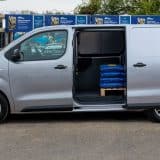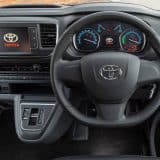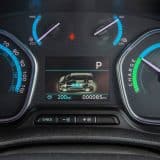Pros:
- Excellent battery-powered range
- Good size payload
- Low running costs
Cons:
- Cabin feels cramped
- Higher price tag than the diesel version
- Just one body size
There’s a lot to like about the Toyota Proace Electric – the firm’s first electric-powered van. It’s a great electric van with a decent payload and a good driving range. However, it’s a similar offering to the Citroen e-Dispatch, the Peugeot e-Expert and Vauxhall Vivaro-e because it is built on the same platform. Unlike those models, the Proace Electric has just one body size but two battery pack sizes to choose from. The one big standout feature for selecting the Proace Electric is that the firm is offering a five-year warranty – whereas the rivals get just three years.
There’s no doubt that the Toyota Proace Electric is a very good battery-powered van, and it’s a good solution for anybody looking for a medium-sized van for everyday use. The driving range is 205 miles and firms should find that this is an accurate figure when driven around town. It’s also a good electric van to lease, though van owners should appreciate that the residual values for the Proace Electric are better than most others in the segment.
Toyota says
Toyota is launching its first zero emission, battery electric vehicle in the UK, the Proace Electric medium-duty panel van, adding a powerful new dimension to its Toyota Professional range of light commercial vehicles.
The new model signals the company’s commitment to applying different electrification technologies to meet different mobility requirements. With a generous driving range of up to 205 miles, the Proace Electric gives customers access to the growing number of low and zero emission zones.
For business users working in urban areas, the extent of the driving range means daily recharging may not be necessary, minimising their vehicle’s downtime.
At present, alternative fuel vehicles (AFVs, including battery electric vehicles) account for only a fraction – around 1.8% – of new LCV sales in the UK, but a number of factors are accelerating demand for practical alternatives to vans with conventional internal combustion engines. Low and zero emission zones are coming into force to reduce local pollution and improve air quality in urban centres, at the same time as rapid growth in e-commerce is generating more day-to-day delivery traffic.
Consumers are actively seeking cleaner forms of transport and large corporations are making electrified vehicles a requirement within their fleet tender processes. Customer interest is also increasing, as manufacturers bring more models to market, and they become more visible on city streets.
Toyota is taking an early initiative with the introduction of the Proace Electric. The new model not only rivals for the best power, performance and charging requirements within its BEV segment, it goes further by delivering just the same quality and load-carrying practicality as its diesel-powered equivalent.
Key customer concerns have been addressed, including the driving range (up to 205 miles), charging times (fast charging to 80% in less than one hour with a 100kW fast charger) and battery quality (eight-year/100,000-mile battery warranty as standard). This makes the Proace Electric a smart choice for customers who need to access low/zero emission zones, giving them the opportunity to develop new, cost-efficient business models that deliver environmental performance while maintaining service levels.
Reasons to buy
For a business or van owner looking to switch from a diesel van, the Toyota Proace Electric is one to consider. It has similar dimensions to the Proace diesel but is more comfortable with lower running costs. There are some minor tweaks onboard and as a mid-level fleet-spec van, the bestselling Icon trim offers a great package. The biggest attraction, however, is the fact that the Proace Electric gets a five-year warranty and not just the three years offered by rival brands. However, this has a 100,000-mile limit but those extra two years could mean a lot to many firms.
If you like the Toyota Proace Electric, then consider the Vauxhall Vivaro-e, or the Nissan e-NV200.
Running Costs
With the everyday running costs lower for the Toyota Proace Electric when compared to the diesel sibling, van owners need to decide which of the two battery sizes will meet their needs.
The batteries are 50kWh or 75kWh and they are mated to an electric motor producing 134 bhp. The smaller battery offers a range of 142 miles, while the larger offering delivers 205 miles.
The Proace Electric is also capable of quick charging so the battery can be recharged to 80% of its capacity in 32 minutes – for the smaller battery it takes 48 minutes. Otherwise, it can take 11 hours using a 7.4 KW charger, or the 11 KW alternative will take just under five hours.
One effective way of reducing the running costs is to sign up for a cheaper electricity deal, particularly when charging overnight when the off-peak tariffs will deliver lower costs of just a few pence per mile.
Load Space
The larger battery pack will offer a payload of 1,226kg, while the smaller battery will offer 1,000 kg for the Toyota Proace Electric. That’s a lot less than the diesel version which offers a payload of 1,487kg.
The Proace Electric is 4,959 mm in length with a load space of 2,512 mm. The interior dimensions are similar to the Vauxhall Vivaro-e and there’s the option of a load-through hatch for the bulkhead that will add 1,158 mm to the maximum length that can be carried.
With the load-through hatch, the maximum load volume also increases to 5.8 m³, from 5.3 m³.
Technology & Safety
The Toyota Proace Electric comes with lots of equipment and technology with more standard kit than its rivals, including a seven-inch infotainment display and an electric parking brake. There’s also onboard Wi-Fi and smartphone compatibility.
Since there is just one trim level, the bestselling Icon, drivers also get automatic wipers and lights, cruise control, manual air-conditioning, rear parking sensors and an acoustic windscreen.
There’s also twin sliding side doors, electric heated door mirrors and a height-adjustable driver’s seat.
Safety equipment for the Proace Electric includes vehicle stability control, tyre pressure warning system, hill start assist and the firm’s eCall system that will call the emergency services should it detect the van has been involved in an accident.
Also fitted as standard is an alarm.
Performance
The Toyota Proace Electric offers a comfortable and refined driving experience, it also has excellent cornering and stability which makes it a sound choice for urban driving. The suspension delivers a smooth ride on rough roads and the powertrain delivers power when necessary.
And while the cabin has been well-designed with a car-like feel, it does feel somewhat cramped and the digital instrument display showing the speed and battery charge is functional.
There are no gears, so there’s no gearstick, drivers simply use a toggle switch to put the car into Drive mode and set off. There are three driving modes and in Normal drivers get the best balance between efficiency and performance but the driving range is restricted.
In Eco mode, drivers get the best out of the battery, while Sport mode delivers a more responsive driving experience with the top speed limited to 80 mph.


